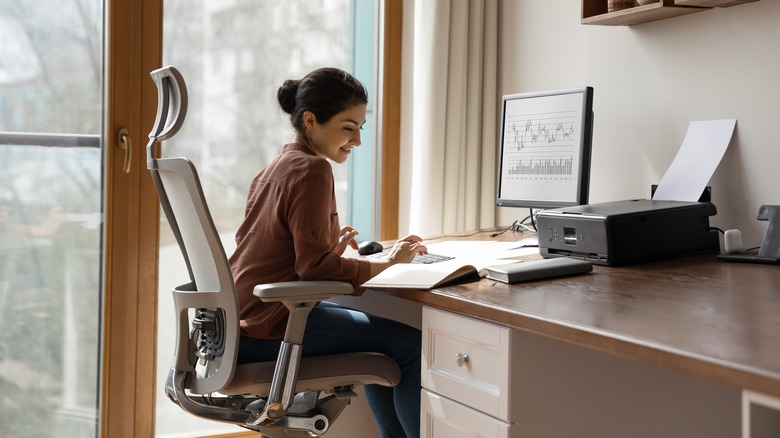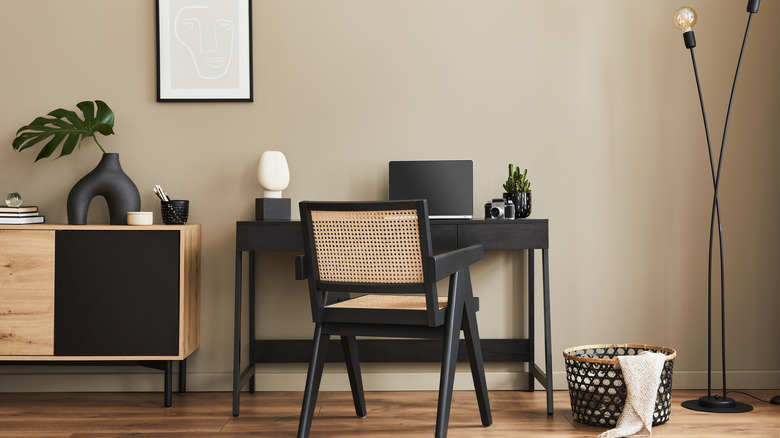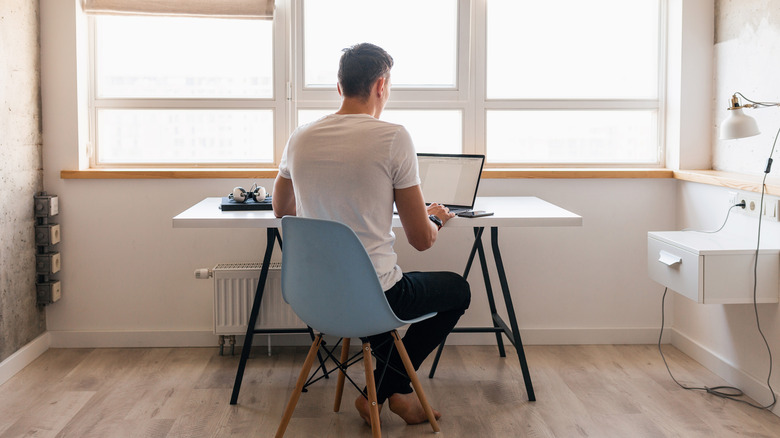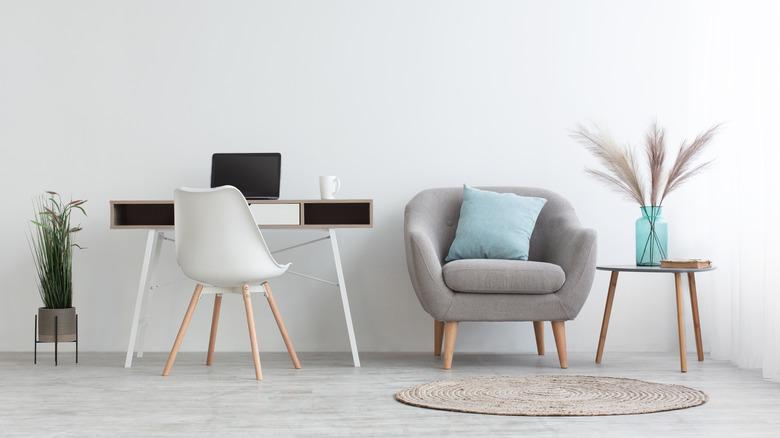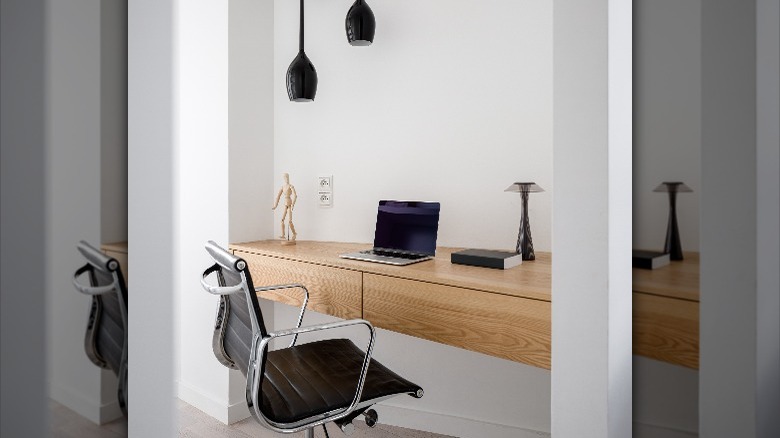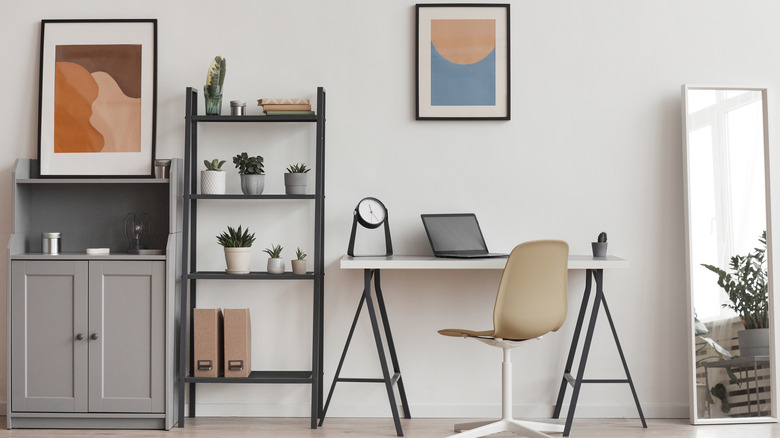5 Trends To Avoid When Decorating Your Home Office
Decorating your home office may impact your work week more than you think. This is because a bare or uncomfortable space may leave you feeling tired, unmotivated, or bored. Taking the time to create a space you genuinely enjoy will make you more excited to start working, which could also encourage and uplift you when tackling a complex project. And it could help you feel alert during the slower periods of the day. Design Depot adds that a personalized home office can increase efficiency, help you take control of clutter, and become a great place to take your much-needed breaks.
However, when designing your office, there are some overdone design choices you'll want to avoid. These trends include purchasing a large desk, placing your desk in the corner, as well as using lots of décors, only dim lighting, and neutral tones. Below are more details on these terrible trends and some alternative ways to decorate your home office.
1. Choosing an oversized desk
The first trend to avoid is purchasing an oversized desk. In the past, large, bulky desks provided extra storage for paperwork. These are sometimes called executive desks and are typically placed in the middle of the room, per Designing Idea. However, nowadays, many at-home workers use minimal amounts of paper — some don't even use any. Because of this, ZenBusiness says that many people opt for a desk with a simple design and minimal storage space. Additionally, large desks can appear outdated and take up lots of space in a home office, while smaller options require less room and are more modern and sleek.
Tom's Guide lists some of the best desks of the year. These mainly include those with minimal drawers and a smaller surface area. They also reviewed standing desks, which have extra health benefits by allowing workers to continue being productive while standing up.
2. Placing your desk in the corner
After choosing the right desk, you also want to keep it out of the corner. Placing your desk in that area could make you feel isolated, claustrophobic, or trapped in a tight space, per FlexiSpot. It would also give you less movement than placing your desk out in the open. When deciding where to place this furniture, there are four main things to consider, per Plank and Pillow.
First, think about if a view would distract or inspire you. If it would encourage you, you could place your desk in front of the window. Second, think about the size of your desk and how it looks in the room. If your desk is tiny, it may not look proportionally correct if placed in the middle of a large room. Third, consider any extra elements in your space. Between two built-in bookshelves or underneath lighting may be the best place. Finally, think about where electrical outlets are placed. If you have an outlet in the middle of the room, you could put your desk there; if not, you may need to set it along the wall.
3. Adding too many decorations
Just as a view may distract you, decorations could also cause you to lose focus easily. This is why you should make sure to minimize the distractions in your space by limiting your interior décor. While picture frames, a clock, plants, and knick-knacks can all add personality, they could also cause you to be less productive.
Curated Interior says that storage bins with lids or drawers will help keep all your items out of sight and well organized, which would allow you to concentrate on your work. Additionally, mixing functionality with aesthetics is a good idea when choosing decorations. For instance, you could hang a stylish bulletin board or planner on the wall. Money Crashers adds that having a dedicated office space only used for working will help you focus on your tasks. And, when styling the space, focus on what you need, like a chair, desk, and technology.
4. Only using dim lighting
In the past, only dim lighting was used in some home office spaces. While this can be relaxing, it can also make it difficult to work. This is because, as Lumens says, dim lighting can cause you to strain your eyes, which could cause a headache. However, bright lighting could also hurt your eyes, too. Therefore, you should focus on adding adequate lighting and the right options to your space. As Curated Interior points out, adding enough bright lights will keep you alert during work.
To this end, fluorescent light bulbs should be avoided. Remodelista says to layer many different kinds of lighting to make your space adequately lit. You could use natural lighting from a window or opt for overhead lights and a table lamp. Dimmer switches may be in your best interest, as they allow you to adjust the light for various tasks, from focusing to being creative to take a break. Finally, don't place bright lights behind you, as they could create a glare and shadows on your computer screen.
5. Only using neutral colors
While neutral colors are gorgeous, only using neutrals is a thing of the past. Instead, many are adding pops of color to their spaces, including their home offices. There are many different ways to add color to your room. PureAlchemy Design suggests painting an accent wall, adding colorful artwork, or organizing bold art supplies. Further, the light bulbs you choose could illuminate your room in gorgeous warm or cool colors. However, don't overdo it with vibrant colors; make sure to balance your office with some neutral elements.
The colors you choose to decorate with can also significantly impact your space. Mocha says that blue increases productivity while also relaxing the mind. Green will never overwhelm and reminds the viewer of nature, making it an excellent option for the office. Bolder choices, like red or yellow, will energize and enthuse. And turquoise may increase your creativity while helping you think more clearly.
